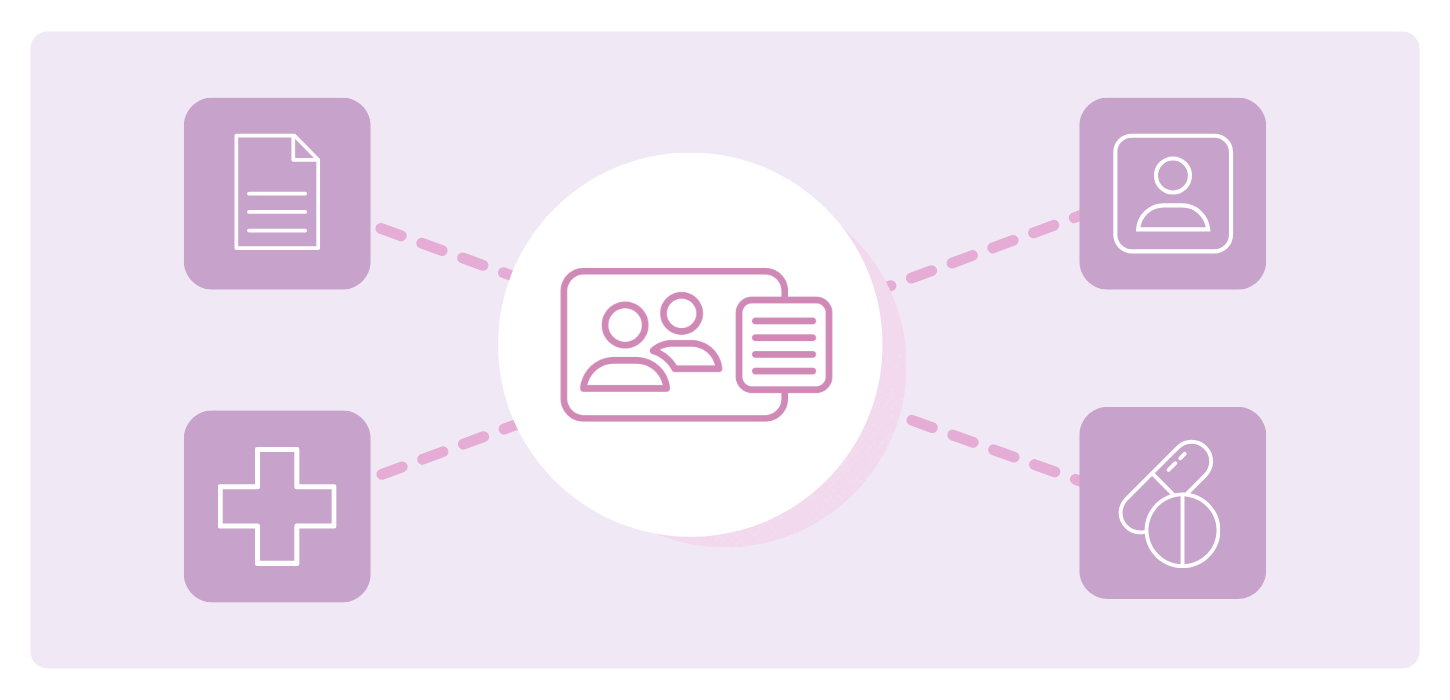At A Glance
Identity resolution unifies fragmented IDs into complete customer profiles, helping companies understand their audiences and deliver personalized, privacy-compliant experiences in a cookie-light world. With Experian’s AI-powered identity resolution solution, marketers gain the scale, accuracy, and compliance to compete while making marketing more human.In this article…
Every marketer has seen it: a customer browses reviews on a laptop, adds items to a cart on mobile, then “disappears.” In reality, they just likely switched devices or logged in with a different email. Identity resolution connects these scattered signals into a single profile so you never lose sight of the customer journey.
Identity resolution is what helps you keep track of customers who bounce around.
Connecting scattered signals into a single customer profile can help you deliver seamless experiences, meet strengthening privacy standards, turn first-party data into measurable results, and fuel better customer analytics.
See our identity resolution solution in action
What is identity resolution?
Identity resolution is the process of pulling together the different identifiers a customer uses and connecting them to a single profile. Without it, you’re left with an incomplete picture of the customer — like a cart tied to one email, an app login tied to another device, or a loyalty swipe that never links back to the same person.

Common identifiers include:
- Cookies: Short-lived browser data
- Emails: Plain-text and hashed
- Device IDs: Mobile advertising IDs (MAIDs) or app-based identifiers
- Loyalty IDs: Program numbers that tie online and offline activity
- Hashed PII: Personally identifiable information (PII) encrypted for privacy
Ultimately, identity resolution can help you recognize the same customer wherever they engage.
Why does identity resolution matter now?
Marketers face incomplete views, data silos, privacy regulations, and shrinking visibility:
- Rising consumer expectations: People want seamless, personalized journeys across touchpoints.
- Privacy-first environment: Consumer privacy legislation (like the GDPR, CCPA, GLBA, FCRA, and new state laws) makes compliance non-negotiable.
- Signal loss: The decline of cookies, MAIDs, and walled gardens are pushing brands toward first-party data.
Experian utilizes AI and machine learning to fill these gaps, predict behaviors, and connect signals across devices — providing marketers with a clear, privacy-safe view of their customers, even when traditional identifiers are missing.
In this environment, identity resolution matters because it gives marketers a way to deliver seamless, personalized customer experiences and engage audiences effectively while respecting their privacy. It’s the basis for turning consented first-party data into measurable marketing outcomes without sacrificing trust.
Why is identity resolution critical in a privacy-first world?
Even as cookies linger, marketers have already shifted their strategies to rely on first-party data, where choice and transparency are the baseline expectation. At Experian, our long history as a regulated data steward makes us a uniquely capable and trusted partner for managing modern compliance expectations. Our identity resolution solutions maximize the value of permission-based data while meeting consumer demand for privacy, personalization, and control.
Struggling with scattered customer data? Experian makes identity resolution seamless
How does identity resolution help brands?
Identity resolution turns fragmented signals into unified profiles that drive personalization, efficiency, and compliance. Here’s how it creates measurable business impact.
Creates a unified customer view
One of the biggest advantages of identity resolution is the ability to integrate data from loyalty programs, point-of-sale (POS) systems, customer relationship management (CRM) platforms, web analytics, and offline sources into a single, comprehensive profile. Experian strengthens identity resolution with AI-driven clustering models that resolve household and individual identities across billions of signals with greater accuracy.

With a clearer picture of each customer, brands see higher match rates and larger addressable audiences, which translates to more substantial reach and better return on ad spend (ROAS).
Enables better personalization
Customers constantly switch devices, update their information, and change preferences. Experian makes it easier to keep pace with these changes through frequent data enrichment and near-real-time identity resolution via Activity Feed.
Combined with our long-standing use of AI and machine learning, this approach ensures shifting behaviors are captured quickly, enabling timely personalization, and more responsive engagement.

With less delay from data to action, the result is faster response times and higher conversion rates.
Improves the customer experience
Customers notice when brands deliver relevant ads and contextual content across every channel. Consistency matters! But consistency doesn’t just happen on its own; it comes from identity resolution, which keeps the customer journey connected.

As brands maintain continuity, they build trust, strengthen engagement, and increase customer lifetime value.
Drives better marketing ROI
Not every profile is valuable. Identity resolution helps marketers identify the highest-value audiences and reduce wasted spend.

That efficiency leads to lower CPA and a higher overall ROI across campaigns.
The power of modeling from a stronger foundation
When you have a unified customer view, your models are built on better data. That means you can find more people who look like your best customers, build more responsive audience segments, and target with greater accuracy. This foundation can lead to better spending, more relevant campaigns, and a higher ROI.
Maintains privacy compliance
With GLBA/FCRA-grade standards and consumer choice mechanisms like opt-outs and data correction, you can protect your brand while maintaining personalization — without compromising legal or ethical safeguards.

What are some identity resolution use cases and examples?
Every industry faces its own unique identity challenges, but identity resolution is the common thread that turns scattered data into connected experiences. Let’s break down how companies in different verticals are putting it to work (and the kinds of results they’re seeing).
Retail and e-commerce
Shoppers bounce between websites, carts, and checkout lines, leaving behind scattered signals in the process. In retail, identity resolution bridges the gap between online and in-store experiences by matching online carts with loyalty swipes or connecting connected TV (CTV) exposure to in-store sales. This means fewer silos, better targeting, and more personalized offers wherever people shop.

Our 2025 Digital trends and predictions report calls out that omnichannel experiences aren’t optional anymore. With CTV and social dominating spend, brands need identity resolution to cut through silos and build a complete view of customer behavior.
Financial services
In financial services, identity resolution makes it possible to deliver personalized, compliant offers like refinancing options for likely mortgage switchers or the right rewards card for frequent spenders.
Our partnership with FMCG Direct to create Consumer Financial Insights® and Financial Personalities® segments helps banks, insurers, and lenders understand behaviors — such as credit card use, deposit balances, and investment habits — without exposing sensitive details.
Read more below about how our financial audiences enable privacy-safe personalization.
Travel and hospitality
Travel decisions aren’t always planned out in advance. Many bookings happen spur-of-the-moment, which is why real-time identity resolution is so powerful; it keeps the journey seamless when travelers jump from phone to laptop to tablet and presents relevant offers right as decisions are being made.
Windstar Cruises put this information into action with Experian’s identity graph to connect digital interactions with actual bookings, which drove 6,500+ reservations and $20 million in revenue.
Media and TV
Viewers tend to hop around between linear TV, streaming apps, and social feeds. And without identity resolution, every screen looks like a different person. Marketers can accurately plan, activate, and measure campaigns by unifying viewing behaviors into one ID with Experian’s AI-powered identity graph.

Optimum Media tackled its multiscreen challenge by partnering with Experian for identity solutions. Layering our audience insights and our AI-driven Digital Graph onto their subscriber data, they were able to connect the dots across channels, reach the right households, and measure results instead of just impressions. In the end, they finally got a clear view of what works across every screen.
Curious how identity resolution can power your customer analytics? We can walk you through it.
Healthcare and pharma
Healthcare marketers can’t afford slip-ups with HIPAA regulations. Identity resolution makes it possible to engage the right patients and providers with de-identified audiences rather than third-party cookies.

At Experian, AI and machine learning have always been part of how we power identity resolution. In healthcare, that means using AI-enhanced modeling to connect de-identified clinical and claims data with lifestyle insights. The result is a more comprehensive picture of the patient journey that helps close care gaps, reduce wasted spending, and improve outcomes.
By working with partners like Komodo, PurpleLab, and Health Union, we make it possible to activate campaigns at scale that boost engagement and adherence while keeping patient privacy front and center:
- Komodo Health enriches our identity graph with insights from millions of de-identified patient journeys plus lifestyle data, giving brands a fuller view of where care gaps exist and how to close them.
- PurpleLab connects real-world clinical and claims data to Experian’s platform, letting advertisers activate HIPAA-compliant audiences across CTV, mobile, and social with the ability to measure real outcomes like prescription lift and provider engagement.
- Health Union contributes a data set built from 50 million+ patient IDs and 44 billion+ patient-reported data points. Combined with our identity and modeling capabilities, this expands match rates and unlocks up to 76% net-new reach, so campaigns reach patients and caregivers in critical health moments.
As a result, healthcare brands can launch campaigns that are privacy-first, highly targeted, and proven to drive meaningful impact.
Audio
People use audio while commuting, working out, and even folding laundry. It can be one of the hardest channels to track because of how frequently listeners switch between apps, stations, and devices.

Experian’s identity resolution partnerships with Audacy and DAX change the game:
- Audacy helps tie scattered listening into a single view, so advertisers can follow audiences across devices and keep ads relevant in the moment.
- DAX pairs Experian’s 2,400+ syndicated audiences with its audio network, enabling brands to target precisely and launch impactful campaigns at scale.
These partnerships turn audio into an accurate channel where ads feel personal, privacy-safe, and measurable.
Gaming
Gamers don’t stick to one platform. Player data gets scattered across mobile, console, and PC, so it’s tough to keep track of individuals. Experian helps stitch those signals together so publishers can finally see the whole picture, personalize gameplay, and keep players coming back.
With enriched profiles, publishers can deliver offers that resonate and unlock fresh revenue by packaging high-value gaming audiences for advertisers outside the industry.
Unity, a leading gaming platform, is tapping into Experian’s syndicated audiences to gain player insights and help advertisers reach gamers across mobile, web, and CTV. For global publishers, unifying player data with Experian has driven higher engagement and stronger ad ROI.
How should I evaluate identity resolution providers?
When choosing an identity resolution partner, look for:
- Data scale and quality: The value of identity resolution depends on how complete and accurate the underlying data is. The right provider should bring together a wide range of identifiers from online and offline sources, maintaining high accuracy so your customer profiles are broad and reliable.
- Match accuracy and recency: The best partners also refresh their data regularly and can blend deterministic (exact, one-to-one matches) with probabilistic (pattern-based matches) methods. That way, you get the accuracy of “this email is definitely that customer” with the reach of “this device likely belongs to the same person.”
- Privacy and compliance readiness: Compliance can’t be an afterthought. Your identity partner should be ready for GLBA, FCRA, GDPR, CCPA, and the latest state-level rules with built-in tools for opt-outs, corrections, and deletions.
- Integration flexibility: A good provider fits into your world, not the other way around. Look for pre-built integrations with your customer data platform (CDP), demand-side platform (DSP), or marketing tech (MarTech) stack so you can get up and running without the heavy IT lift.
- Data analytics capabilities: You need proof that identity resolution drives ROI. Look for closed-loop measurement that ties unified IDs directly to campaign performance, so you can see what’s working and optimize with confidence.
How Experian enables enterprise-grade identity resolution
Experian delivers identity resolution at the scale, accuracy, and compliance required by the world’s largest enterprises. Our solutions are:
- Built on trust: Backed by 40+ years as a regulated data steward and rated #1 in data accuracy by Truthset, so you can act with confidence.
- Powered by our proprietary AI-enhanced identity graph: Combining breadth, accuracy, and recency across four billion identifiers, continuously refined by machine learning for maximum accuracy.
- Seamlessly connected: Pre-built data integration with leading CDPs, DSPs, and MarTech platforms for faster time to value.
- Always up to date: Frequent enrichment and near-real-time identity resolution through Activity Feed for timely personalization and more responsive customer engagement.
- Privacy-first by design: Compliance with GLBA, FCRA, and emerging state regulations baked in at every step, supported by rigorous partner vetting.
The bottom line
Identity resolution turns fragmented signals into connected, measurable, and compliant experiences. From retail to gaming, brands using it see stronger personalization, engagement, and ROI.
With Experian, you get the data, trust, and responsible AI innovation to make identity resolution work across every channel. Our approach uses AI to connect identities, predict behaviors, and deliver personalization that balances privacy with performance. If you’re ready to turn fragmented data into growth, now’s the time to start.
The world’s leading brands trust us to power identity resolution at scale. See how we can do the same for you.
Identity resolution FAQs
Deterministic uses exact identifiers (like an email) for accuracy, while probabilistic uses signals and algorithms to expand reach. Best-in-class providers usually combine both.
Identity resolution helps with personalization by unifying scattered signals into one profile. It reduces wasted spend and increases match rates, which means bigger addressable audiences and higher ROAS.
Yes. With first-party data and hashed PII, brands can still maintain addressability and personalization.
Retail, finance, travel, media, gaming, and audio all use identity resolution to personalize, attribute sales, and improve efficiency.
A customer data platform unifies the data you already own. Meanwhile, we add depth, scale, and higher match rates by layering in our identity graph and data enrichment.
Yes. Experian is GLBA/FCRA compliant, GDPR/CCPA ready, and supports consumer opt-outs and corrections to ensure responsible personalization.
Latest posts

In this article…The rise of omnichannel retailingData and identity-related retail marketing challengesStrategies to help you overcome retail marketing challengesExperian can help advance your retail marketing strategies The questions that keep retail marketers up at night have evolved significantly over the last decade. It wasn’t long ago that marketers would spend their time debating which highway to place their billboard on, whether or not their next TV commercial should be comical or heart-tugging, or even what the optimal time of day was to blast an email campaign to their entire customer list. In 2024, retail marketing has new challenges on the radar. The rise of omnichannel retailing The modern, digital-savvy customer expects a flawless and interconnected shopping experience across touchpoints — one of the many reasons omnichannel marketing is on the rise. Research shows that over half of B2C consumers engage with between three and five channels whenever they make a purchase. For businesses, omnichannel engagement is a lucrative opportunity; McKinsey reports that customers who engage across channels shop nearly twice as much as those using a single channel and usually spend more money. However, the rise in omnichannel engagement also presents several retail marketing challenges, such as the complexity of managing vast amounts of data and piecing together an accurate picture of consumer behavior. Data and identity-related retail marketing challenges Today’s data-driven environment has turned the retail marketing landscape on its head, and businesses have a whole new set of struggles that revolve around identity and data. We identified the top five retail marketing challenges and how to solve them. 1. Knowing what data to capture In the omnichannel era, online and offline data is abundant. When a customer shops at a physical store, they create data points like: What items they purchased What time they visited How long they were there When the same customer shops online, they create a whole new set of data points, such as: What device they used Which items they browsed but didn’t purchase How long they spent on specific pages The vast available data can overwhelm retailers and make it a challenge to determine which data points to prioritize. Start by identifying the challenge you’re addressing. By defining your problem, you can better decide which data is most relevant. For instance, if you’re optimizing the timing of incentives, analyze when customers shop most frequently and customize offers based on individual behavior patterns. How Experian’s Activity Feed can help Experian Activity Feed connects online and offline data to promote precise targeting and measurement across mobile, web, connected TV (CTV), and more. We provide addressable insights that work across all channels by integrating real-time device IDs, cookies, and IP addresses. Our case study with Cuebiq, found here, discusses how we used Activity Feed to deliver in-store lift analyses to Cuebiq’s clients. Because our impressive breadth of addressable data works across channels, we’re perfectly positioned to be your comprehensive identity solution, as we’re capable of addressing the entire U.S. population. With access to over 250 behavioral and demographic attributes per individual, our data fills in audience gaps to help you create a complete customer profile. 2. Understanding customer behavior The complexity of modern consumer behavior is growing, and one of the biggest retail marketing challenges is merging all this information into a single unified customer view. With consumers moving seamlessly between devices like tablets, mobile phones, and laptops, retailers face the grueling task of keeping up with their fragmented journey. For instance, a customer may spot a pair of shoes in-store, add them to their cart via mobile due to long cashier lines, and finish the purchase later from their laptop. However, if they cannot be recognized across these touchpoints, they may abandon the purchase out of frustration. Retailers need solutions that link offline customer relationship management (CRM) and purchase data with a customer's online activity, regardless of channel or device. This is where Experian identity resolution and Graph come into play. How Experian’s Graph and identity resolution can help Experian’s identity solutions help brands resolve disparate data by merging fragmented identifiers into a singular customer profile for a 360-degree view. We ensure each touchpoint is connected, whether the interaction happens online or offline, across mobile apps, or in-store. This enables retailers to recognize the same customer across various devices and enhances the customer experience by keeping items in their cart and personalizing their journey across platforms. With Experian’s identity graph, brands can further enrich these customer profiles with digital identifiers that span hashed emails (HEMs), cookies, mobile device IDs (MAIDs), IP addresses, universal IDs, and CTV IDs to create a more accurate, actionable view of consumer behavior. We rebuild the graph weekly, which ensures persistent and refreshed connections between households, individuals, and their devices. This ongoing linkage allows for precise targeting and measurement over time and aligns with privacy standards and compliance obligations. By organizing identity into households and device IDs and enriching them with marketing data, brands can gain deeper customer insights, addressability across devices, and the ability to measure the impact of their retail marketing strategies. 3. Building trust between consumers and your brand Trust is the foundation of online relationships, and consumers who trust your brand are likelier to share their data. To establish this trust, retailers must collect customer data transparently and respectfully. According to Experian data, 80% of consumers believe more transparency around the use of their information fosters greater trust in a business. Additionally, the same data revealed that 56% of companies plan to invest more in transparency initiatives, such as consumer education, clearer terms of communication, and consumer control over personal data. Experian’s commitment to data accuracy and transparency further strengthens this trust. Our data is ranked #1 in accuracy by Truthset, which means you can power smarter insights, targeting, and measurement using the highest-rated, most reliable data to build customer profiles. 4. Establishing customer loyalty with retail marketing Today’s consumer has many opportunities and choices available at their fingertips, which makes it harder for retailers to build and maintain customer loyalty. Signal loss and the rise of omnichannel media consumption have made it even more of a challenge to keep loyal customers. By using data and insights to interact with people more meaningfully, you can overcome these difficulties to provide a more personalized, relevant experience and establish loyalty. Experian’s new Digital Graph and Marketing Attributes solution makes it easier to do just that. Experian’s Digital Graph and Marketing Attributes solution Using our Digital Graph and Marketing Attributes, you can gain comprehensive insights into consumer behavior by combining offline and digital data through our Living Unit ID (LUID). Our Digital Graph provides robust digital identifiers like MAIDs, CTV IDs, HEMs, and universal IDs, while our Marketing Attributes offer detailed consumer insights spanning age, gender, purchase behaviors, and content consumption habits. With this data, you can create relevant messaging and informed audience segmentation to enhance your personalization and targeting efforts across all digital channels. Using our solution can help you deliver what customers need when they need it — like winter gear before a ski trip or swimwear before a beach vacation. These personalized experiences drive additional revenue and build lasting relationships that keep customers coming back, establishing a strong foundation of loyalty in an increasingly competitive market. 5. Finding your technology solution Retailers need to integrate technology to make their data actionable and use it to streamline the customer experience. They need to integrate data storage platforms with fulfillment and reporting solutions, such as email service providers, display networks, and marketing intelligence tools. Whether retailers are exploring the industry or gearing up to make a substantial investment in the right technology partner, it’s vital to ensure you evaluate potential partners equally and consistently. Experian works with major platforms, marketers, and agencies, meaning we have existing partnerships across the ecosystem for you to connect with that can bring your consumer data to life and meet your needs. Our offline and digital graphs are baked into partner integrations so customers can achieve higher match rates that improve addressability. Strategies to help you overcome retail marketing challenges When it comes to modern retail marketing, you’ll need to take a strategic approach to handle emerging challenges. Here are five retail trends of 2024 to consider integrating into your retail marketing strategy: Use predictive analytics: Data can be overwhelming, but you can analyze historical purchase patterns to capture and prioritize the most relevant data for your retail marketing efforts. Optimize omnichannel campaigns: Cross-channel data integration can help you ensure consistent messaging, provide a seamless experience, capture a unified view of customer interactions, and improve engagement. Personalize experiences with AI: Utilize AI data capture across touchpoints to create personalized recommendations and tailored experiences that resonate with individual customer preferences and behaviors. Adopt dynamic pricing: Use real-time data to adjust prices based on customer behavior and market conditions so your pricing strategies align with current demand and maximize revenue. Invest in customer experience tech: Virtual fitting rooms, augmented reality, and other advanced technologies allow customers to engage with your brand across platforms, which can improve their shopping experience. Utilize Experian’s retail media network (RMN) solution Experian’s solution for RMNs is another tool for overcoming retail marketing challenges. We empower RMNs to better understand their customers with unified views of online and offline behavior across channels and extend their reach across environments. Using our top-ranked identity and audience services, we can help RMNs access expanded customer insights, enhance cross-channel audience targeting, and improve real-time measurement and attribution to enable precise, streamlined, personalized omnichannel campaigns. Our solution’s integration with major platforms improves data match rates and addressability so retailers can overcome data fragmentation and optimize their retail marketing strategies. Experian can help advance your retail marketing strategies Experian can help retailers effectively use data and insights to interact with customers and prospects meaningfully. Our data and identity solutions help you deliver relevant, impactful messaging to ensure the customer who puts shoes in the cart at the store is the same customer who wants to finalize their transaction later that evening online. As the holiday season approaches, it’s time to refine your retail marketing strategies and connect authentically with shoppers. With over a billion consumers preparing to shop, Experian offers 19 new syndicated audiences available for activation across major ad platforms, including TV and programmatic, to help you reach the most relevant prospects. Whether you’re targeting discount seekers, last-minute gift-buyers, or frequent travelers, our audiences align with diverse shopping styles and preferences. Choosing the right audience segments aligns your holiday marketing efforts with consumer expectations and maximizes impact. With our tools, you can seamlessly connect with the same customer across various channels, whether they’re shopping in-store or online. Embrace the holiday season confidently, and let Experian help your retail marketing strategy shine. Get started with us today Latest posts

The holiday season is almost here, and knowing how each generation plans to shop can give your holiday advertising campaigns the edge you need. Our recent survey of 1,000 U.S. consumers reveals 2024 holiday shopping trends for each generation and key insights into their anticipated spending levels, preferred shopping categories, and how they look for gift ideas. In this blog post, we'll explore three 2024 holiday shopping trends across generations: Projected consumer spending Top categories on shoppers' lists Preferred channels for researching gifts Download our 2024 report 1. Projected consumer spending Over 1 in 3 Gen Z and Millennials are gearing up to increase their holiday budgets this year, while Gen X and Boomers are likelier to stick to last year's budget. 36% of Millennials and Gen Z plan to spend more this holiday season 45% of Gen X and 52% of Boomers expect their spending to remain consistent with last year What this means for marketers These insights highlight the importance of tailoring your messaging. For Gen Z and Millennials, emphasize value and unique offerings that justify increased spending. For Gen X and Boomers, focus on trust and reliability, reinforcing their confidence in your brand. How Experian can help you target these audiences Experian’s custom and syndicated audience segments, including Holiday Shopper High Spenders and Holiday Shopper Moderate Spenders, enable you to connect with these diverse consumer groups. Our audiences are available on-the-shelf of leading ad platforms to help you reach people across social, TV, and mobile. The election effect U.S. holiday retail sales saw 4.1% YoY growth in 2016 and 8.3% YoY growth in 2020 following presidential elections. There’s a chance that holiday spending increases after the 2024 election, regardless of the outcome. Experian has 240+ politically relevant audiences that you can activate across major ad platforms ahead of the upcoming election. 2. Top categories on shoppers' lists Different generations have distinct preferences when it comes to what they plan to buy. Gift cards top the list for Gen X and Boomers, while Gen Z leans toward clothing. Millennials are looking to splurge on toys, electronics, and experiences. 69% of Boomers and Gen X plan to purchase gift cards 72% of Gen Z will buy clothing 45% of Millennials will buy health and beauty items 25% of Millennials will buy tickets and 22% of Millennials will buy experiences What this means for marketers Align your product offerings and promotions with each generation's preferences to capture their attention. For example, highlighting versatile gift cards may resonate more with older generations, while showcasing trendy apparel and tech gadgets will appeal to younger consumers. How Experian can help you target these shoppers We offer audience segments like Holiday Shoppers: Apparel, Cosmetics & Beauty Spenders, and Toys Shoppers that you can activate to connect with consumers primed to purchase in these categories. We recently released 19 new holiday shopping audiences we recommend targeting to drive engagement and conversions. Download our audience recommendations here. 3. Preferred channels for researching gift ideas When it comes to finding the perfect gifts, Gen Z turns to social media, while Millennials prefer online reviews and video content. Boomers and Gen X are more inclined to visit physical stores for hands-on product evaluations. 29% of Gen Z and 26% of Millennials will look for gift ideas on social media 44% of Millennials will rely on video reviews and product demos on platforms like YouTube 49% of Gen X and Boomers plan to visit physical stores to evaluate products in person What this means for marketers Understanding where each generation looks for inspiration can guide your content and ad placement strategy. To engage Gen Z, focus on social media campaigns and influencer partnerships. For Millennials, consider investing in video content and reviews. For older generations, ensure your in-store experience is optimized to convert browsing into purchases. How Experian can help you engage these shoppers Our TrueTouchTM audiences can help you pair the perfect messaging styles with the right channels and calls to action. Our Social media channel and content engagement audiences can help you reach Gen Z who are likely to be active users on major social platforms and are Black Friday shoppers. For a full list of Experian’s syndicated audiences and activation destinations, download our syndicated audiences guide. Download our new 2025 Holiday spending trends and insights report This holiday season is about more than just transactions – it’s about cultivating meaningful connections with your audience. Download our 2025 Holiday spending trends and insights report, in collaboration with GroundTruth, to access all of our predictions for this year’s holiday season. Download now When you work with Experian for your holiday shopping campaigns, you’re getting: Accurate consumer insights: Better understand your customers’ behavioral and demographic attributes with our #1 ranked data covering the full U.S. population. Signal-agnostic identity solutions: Our deep understanding of people in the offline and digital worlds provides you with a persistent linkage of personally identifiable information (PII) data and digital IDs, ensuring you accurate cross-device targeting, addressability and measurement. Secure connectivity: Bring data and identity to life in a way that meets your needs by securely sharing data between partners, utilizing the integrations we have across the ecosystem, and using our marketing data in flexible ways. Make the most of this holiday shopping season with Experian. Contact us today to get started. Contact us Source Online survey conducted in June, 2024 among n=1,000 U.S. adults 18+. Sample balanced to look like the general population on key demographics (age, gender, household income, ethnicity, and region). Latest posts

Today, Experian is excited to introduce our Offline Graph as a standalone product that clients can license, marking a significant step in our commitment to powering data-driven advertising through connectivity. Offline Graph empowers advertisers and advertising technology companies to build and refine consumer profiles, contributing to data connectivity, more offline audience reach, and improved offline measurement accuracy. As a result of consumers engaging with content across more channels, there are more disparate data points than ever before. When you couple that with ongoing signal loss, the need for a unified identity solution has never been greater. Experian’s Offline Graph offers companies a license of stable offline data points, like name, address, phone number, email, geographic information, date of birth, and additional attributes that provide a complete view of household and individual identities. The Offline Graph integrates known offline identity information from reliable deterministic sources like property ownership records, public records, and marketing data to provide access to all United States consumers and households. How customers can use the Offline Graph A big box retailer fills in the blanks of their existing customer data and builds a database of prospects. A media platform more effectively onboards advertisers’ segments, enabling advertisers to reach more of their customers. A retail brand better understands their customer’s demographic and behavioral make-up, by licensing Offline Graph with Marketing Attributes. A connected TV (CTV) manufacturer increases audience reach and accurately quantifies the campaign impact for their advertising partners. Experian’s Offline Graph is already driving value across industries. Here’s some in-depth client success stories: Fusion92 licenses Offline Graph to help their clients transform their marketing Fusion92 is a marketing partner that fuels business transformation in today’s digital economy and delivers exponential returns for brands. Fusion92 licenses Experian’s Offline Graph to power their strategy: from research and discovery to audience creation, activation, and measurement. With access to our Offline Graph, Fusion92 ensures their clients get the insights, targeting, reach, and measurement they need to achieve their business goals. "At Fusion92, we are always pushing the envelope to develop solutions that lead to success for our clients. Our desire to innovate pushed us to find an industry-leading partner in data and identity. This led to us licensing Experian’s Offline Graph product, which we use to build more complete audience profiles for our clients. In doing so, we help brands target, activate, and measure their marketing campaigns more effectively, leading to superior results.”dave nugent, executive vice president of data and analytics, fusion92 Using Offline Graph to deliver relevant messaging to multiple audience cohorts A leading direct-to-consumer (DTC) company with strong customer relationships built a robust first-party data set, enabling effective customer retention. To attract new customers, they partnered with Experian to access offline identity data from Experian’s Offline Graph. The Offline Graph provides them with the data needed to validate their first-party data and with the keys to unlock new customers. With this data, the DTC company delivered the right message to both sets of consumers: existing customers and new prospects. By integrating Experian’s Offline Graph they broadened their reach, personalized their messaging, and improved their marketing. What sets Experian’s Offline Graph apart from the competition Stability of data: With data from deterministic sources, our Offline Graph ensures that your view of consumers – and your ability to connect with them – is stable over time. Connected digital and offline data: Seamlessly connect offline data with digital identifiers through our Digital Graph, enabling a holistic approach to marketing, while ensuring consumer privacy is prioritized. Tailor made for your use cases: Build the Offline Graph to fit your specific needs, selecting the exact offline identity information required for your campaigns. Expanded consumer insights: Connect more data points to enrich your understanding of consumer demographics and behavior, using Experian’s Marketing Attributes and Audiences data. Offline Graph: Your gateway to consumer connectivity As signals fade, there is a large emphasis on procuring and having accurate consumer data. Experian’s Offline Graph delivers the connectivity and insights necessary to stay ahead. Whether you aim to strengthen your existing data or access entirely new data sets, Experian’s Offline Graph offers a solution tailored to your needs. Transform your data strategy with Experian’s Offline Graph — your gateway to a unified consumer identity solution. Contact us Latest posts